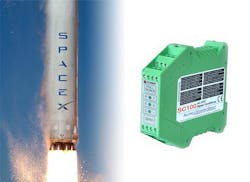Alliance Sensors Group Partners with Spacex on Falcon 9 Rocket
This story has been updated to include information on Macro Sensors.
On April 14, 2014 the SpaceX Falcon 9 will launch from Cape Canaveral, FL to deliver 8,000 pounds of supplies to the international Space Station. Alliance Sensors Group will be part of the historic accomplishment when the company’s SC-100 LVDT signal conditioners do their jobs as part of the ground systems.
“Alliance Sensors Group takes great pride in working with the aerospace community. We love the challenge and are excited to partner with Spacex who is working on such revolutionary projects,” says Harold Schaevitz president and CEO of Alliance.
Schaevitz says the $100m Falcon 9 has “a remarkably new feature. Instead of falling into the ocean never to be used again, this rocket will slow itself with rocket boosters and fall slowly into the ocean,” allowing it to be used again.
The Falcon 9 rocket has been designed and manufactured by SpaceX for the reliable and safe transport of satellites and the Dragon spacecraft into orbit. Re-using the rocket dramatically reduces the cost of sending material and equipment into space, and the ultimate goal is to have the rocket land on metal legs. For added safety, the Falcon 9’s simple two-stage configuration minimizes the number of separation events, and its nine first-stage engines are configured so the rocket can safely complete its mission even in the event of an engine shutdown.
Linear variable differential transformers (LVDTs), also called “differential transformers” or “linear variable displacement transducers” are used to measure position. LVDTs are used to take measurements of the Falcon 9 rocket prior to launch. Alliance Sensor Group’s SC-100 LVDT signal conditioners are being used in coordination with LVDTs as part of the Falcon 9’s ground systems. Macro Sensors' LVDT linear position sensors provide the critical feedback measurement so that the signal conditioners can create a measurable output for readout.
“They were selected because they were built in the United States and due to their ease of set-up,” says Schaevitz. “The SC-100 uses microprocessing to reduce calibration time from 20 minutes down to just a few.” Alliance Sensors Group is headquartered in Moorestown, N.J.
About the Author
Renee Bassett
Managing Editor

Leaders relevant to this article:
